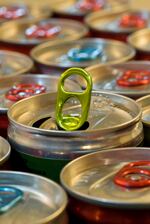Asked about rumors that a document would be published in the next six weeks, a spokesman confirmed to FoodNavigator-USA that it would be released “within the coming few months”.
FDA 2009 draft guidance: If it looks like a conventional food or beverage, it should be marketed as one
Draft guidance on this issue - which was published in December 2009 - has been sitting in the industry’s living room like a large white elephant ever since, according to food law attorneys.
The 2009 guidance (click here) partly reflected concerns about the growing number of functional/energy drinks containing caffeine and other active ingredients that were classified as supplements but looked like soda, which consumers often guzzle in large quantities without scrutinizing labels for advice on serving sizes.
As a result, said the 2009 document, the FDA would consider “a liquid product’s name, packaging, serving size, and recommended conditions of use, as well as other representations about the product, to be important determinants of whether it is represented as a conventional food and may not be marketed as a dietary supplement”.
In other words, if a product looks like a conventional food or beverage, it should be marketed as one.
Food vs supplement: Why does it matter?
But why does this matter? Can’t firms just reposition liquid supplements as beverages - as Monster Beverage Corp recently did for its Monster Energy drinks - to ensure compliance?
Not necessarily, say the lawyers. If you are selling a food or beverage, all your ingredients must be approved food additives or Generally Recognized as Safe (GRAS) for intended use.
But there are plenty of supplements currently on the market containing ingredients such as gingko, melatonin and various botanical ingredients that are not GRAS for their intended use, claimed Steven Shapiro, partner at New York City-based law firm Shapiro & Ullman, LLP.
And they could be in trouble if the FDA concludes that for regulatory purposes, they are in fact foods or beverages, he told FoodNavigator-USA.
Rockstar, for example, received an FDA warning letter last year alleging that its Roasted Coffee & Energy liquid supplements were adulterated because they were “represented for use as conventional foods” [sold in cans and described as a ‘refreshing beverage’], but contained ginkgo biloba leaf extract, which was not an approved food additive and had not been determined GRAS in the products in question.
Attorney: I see this guidance as an attempt to whack off a giant chunk of DSHEA

If the finalized guidance mirrors the 2009 draft, and the FDA aggressively enforce it, scores of products currently marketed as supplements might have to be repositioned as foods or beverages, predicted Shapiro.
He added: “If that becomes the precedent – a supplement bar has the physical attributes of a candy bar and a powdered dietary supplement has the physical attributes of any number of conventional foods. Where does this end?
“What if I sell an empty bottle with the powder and you add the water? Can that be a dietary supplement? Will the amount of liquid added to the powders suddenly make them conventional food?”
As for non-GRAS ingredients, he said: “The primary purpose of DSHEA [the 1994 Dietary Supplement Health and Education Act] was that many of the ingredients used in dietary supplements were not approved food additives or GRAS. So a new statutory standard was set up. Isn’t this a step back?”
On-pack claims could also be affected, he added, as structure/function claims have different statutory requirements when the product is a dietary supplement as opposed to a conventional food.
“This too, may become a very big issue if companies are forced to convert products into conventional foods. The bottom line is that this is a lot more than a ‘band aid’ attempt to deal with a few energy drinks perceived to be problematic. I see this guidance as an attempt to whack off a giant chunk of DSHEA.”
Caffeine and GRAS: ‘I’d be amazed if the major energy drink companies had not spent the money on GRAS determinations to affirm the safety of using caffeine in their products at whatever level they use it

But what about caffeine? What are the implications for industry if certain caffeine-containing supplements must be re-classified as foods or beverages?
There is a lot of confusion out there on this particular topic, said Justin Prochnow, an attorney in the Denver office of law firm Greenberg Traurig.
“Caffeine is listed as GRAS for use in cola-type beverages at 200ppm or 71 mg per 12oz. But contrary to what you sometimes read in the media, this is not a maximum limit and does not prohibit firms from using it in higher amounts in other products such as energy drinks, as long as they have determined that these products are GRAS.
“In fact I would be amazed if the major energy drink companies had not spent the money on GRAS determinations to affirm the safety of using caffeine in their products at whatever level they use it. After all, all the FDA has to do is ask and they will have to provide it.”
If FDA does act on caffeine, most likely action is mandatory labeling of mg/serving

As for labeling, beverage firms are not required to list how much caffeine is in their products (although many now state this voluntarily), he said. However, supplement companies are required to do so, except where the caffeine is part of a proprietary blend, or is derived from ingredients that naturally contain caffeine such as guarana or yerba mate.
And given that in many supplements such as 5-Hour Energy, caffeine is part of a proprietary blend, the reality is that “there is not really a big difference in labeling requirements between foods and supplements”, he argued.
If the FDA does decide to act on caffeine, he predicted, the most likely action will be a requirement for mandatory caffeine labeling on foods and supplements (mg/serving), which would not worry many companies given that they are already voluntarily providing this information in accordance with best practice guidance from trade associations.
Click here to read the letter the FDA sent to Senator Richard Durbin on August 10 clarifying many of the the regulatory issues surrounding energy drinks and supplements.
In the letter, the FDA notes that the Flavor and Extract Manufacturers Association of the US (FEMA) considers taurine (an amino acid) to be GRAS for flavor use, while guarana extract (from the plant Paullinia cupana) is an approved food additive for flavor use in conventional foods and beverages.
